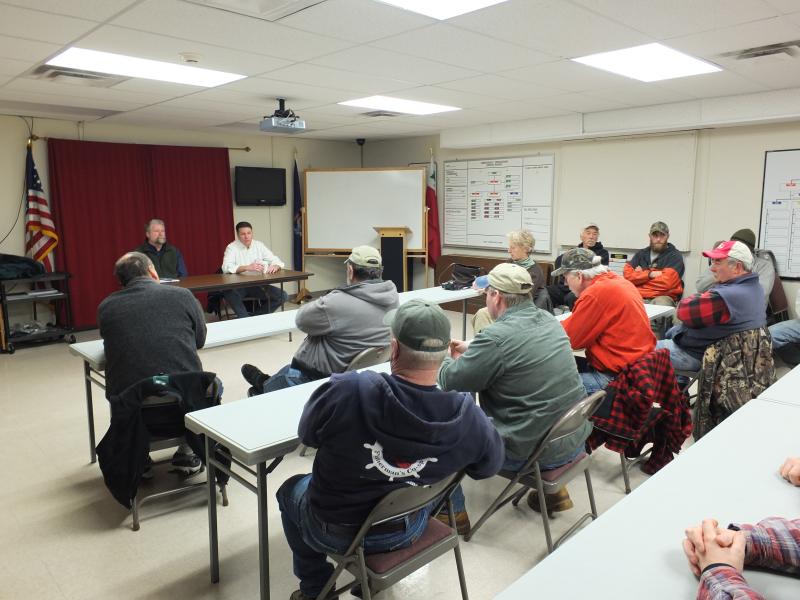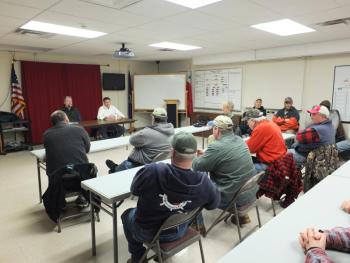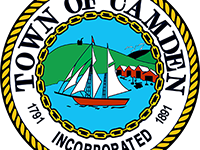Smaller shrimp catch rates reported, price climbs
WISCASSET — Boothbay Harbor fisherman Rusty Brewer is baiting and setting just a portion of his shrimp traps this week, knowing he is working with an even more limited catch than expected. The same holds for South Thomaston fisherman Eric Waterman, who, trawls for shrimp. He is already planning to hang up his nets for the season.
Brewer joined approximately 40 other members of the Maine Shrimp Trappers Association and Maine Department of Marine Resources officials Feb. 1 in Wiscasset to talk about challenges facing an already devastated fishery. While prices are up, almost $2 per pound for fishermen, stock reports show steep declines in shrimp populations.
In early December, the Atlantic States Marine Fisheries Commission Northern Shrimp Section, the regulatory body that oversees the fishery in the states of Maine, New Hampshire and Massachusetts, set the Total Allowable Catch (TAC) of shrimp at 625 metric tons. This was after a technical committee recommended there not be a shrimp fishery at all.
The interstate management plan for this fishery allocates 13 percent of the total catch to those who use traps (which this year comes to just over 80 metric tons) and 87 percent to those who trawl for shrimp.
The TAC is a fraction of what fishermen were allowed to catch last season, but for those who have invested in the equipment it is not just about making a profit; it is also about survival. There will be four-day advance notice of closure when either fishery reaches 85 percent of their respective limits.
Sen. Chris Johnson (D-Somerville),chairman of the Marine Resources Committee, and committee member Rep. Ellen Winchenbach (R-Waldoboro) also attended the session with DMR Commissioner Patrick Keliher, External Affairs Director Terry Stockwell and others.
Shrimp trap fishermen agreed to dramatically decrease their daily catch to 500 pounds (down from 800 pounds) for the first week of their season, which begins on Feb. 5. As the week progresses, officials will monitor landing reports and will notify fishermen of any changes to the regulations.
Keliher and Stockwell stressed it was important for fishermen not to exceed their quota. However, they said they want to see that fishermen are still able to generate some income from a fishery this year. The DMR officials asked fishermen to work with the department to report how much they catch.
Boats have been trawling for shrimp since Jan. 23, but sporadic landing reports show small catches. Keliher said the department has had some difficulty getting reports from some 175 dealers out there and asked for fishermen's cooperation.
"It looks like the science is proving itself right, based on what we're seeing on the trawl side," Keliher said.
Out of about a 540 metric ton trawl limit, approximately 80 metric tons were reported to have been caught within the first three days of their fishery, he said, adding that overall catch rates are down.
As with other markets, low hauls and high demand translates to higher prices. Lisa Wiggan, whose family operates Jess's Market in Rockland, said prices have climbed since the season began. To start out, the shop paid more to pickers who supply the shop than they paid last season, Wiggan said, and on Feb. 1 the price jumped a dollar more per pound.
The cost for fishermen who either set and drag nets or who haul traps is high, so deciding whether or not to go out is a bit of a gamble. According to South Thomaston fisherman Eric Waterman, common practice dictates that fishermen have to catch about 150 pounds per hour to turn a profit. Waterman said he has gone out to haul for shrimp every available day so far this season and has spoken with many other fishermen about what they have seen. Many have said they are not hauling in enough shrimp to turn a profit.
Waterman's largest haul out of Muscongus Bay so far this season was 700 pounds from three trawls, from sunrise to 3 p.m., when fishermen have to hang their nets up for the day. His lowest haul on record this year was less than 180 pounds all day.
"It's been up and down for everybody," Waterman said, adding that stories of good hauls in the southern part of the state have changed in a very short period of time. He concluded, "There's nobody shrimping who's putting money in the bank."
Waterman said he was planning on going out for one last haul on Monday before hanging his nets up for the season.
Trap fishermen expressed their concern about the percentage of the total catch they are allocated. Even with an increase in the number of trapping licenses, the percentage has remained the same, argued one who said, "We're getting discriminated against."
Brewer said he would set about 96 traps on Sunday and will haul on Tuesday like the others, but isn't sure what to expect. The price per pound fishermen get is nearly double that of last year's price, but, he said: "it's not about the profit. It's about getting the numbers and keeping your foot in the door so you don't get squeezed out."
The percentage allocated to trap fishermen is linked to what they caught in previous years and those in the industry want to maintain a catch history to ensure future harvests. While trawl and trap fishing are given separate quotas, one affects the other as they seek the same species.
Many variables make predicting shrimp migration difficult, but like other fishermen, Brewer relies on certain indicators, like the temperature of the water, the migration of lobster or the cycle of the moon, to determine the best time to set his traps. He doesn't know what this season will bring, but said, "If my helper can make a little money and I break even, I'm happy."
Event Date
Address
United States


























